How to Install Kitchen Cabinets Step by Step
How to Install Kitchen Cabinets
With these basic techniques, you can learn how to install kitchen cabinets straight, solid and true
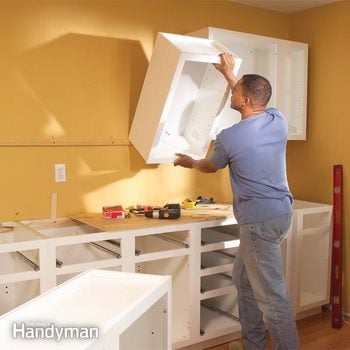 Family Handyman
Family Handyman
Install kitchen cabinets—base, wall and peninsula—using professional techniques. Hanging cabinets is easy and you'll save on your next kitchen remodel.
You might also like: TBD
- Time
- Complexity
- Cost
- A full day
- Intermediate
- Less than $20
Learn how to build your own custom kitchen cabinets without the custom price: Check out How to Build Kitchen Cabinets taught by Steve Maxwell!
How to Install Kitchen Cabinets Step 1: Order the cabinets and assemble key tools and materials
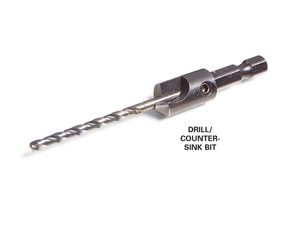
Special combination drill bit
This special bit saves time because it bores a pilot hole for the screw and a countersink hole for the screw head.
Learning how to install kitchen cabinets may seem intimidating, but the techniques are really quite simple. Think of it as screwing a series of boxes to the wall and to one another in the proper sequence. If your cabinet plan is correct, your main job is to find the best starting point and keep everything level. In this story we'll show you how to install kitchen cabinets and master these key steps. We'll tell you how to lay out the cabinet positions ahead of time to avoid missteps. Then we'll show you how to install the base cabinets so they're perfectly aligned and ready to be measured for the new countertop. Last, we'll show you a simple method for installing the upper wall cabinets. The entire how to install kitchen cabinets project typically takes less than a day. And depending on how large and elaborate your kitchen is, you'll save at least $500 (and probably much more) in installation charges.
You only need a few basic tools to do a first-class job. You'll need an accurate 4-ft. level, a screw gun powerful enough to drive 2-1/2-in. screws and a couple of good screw clamps that open to at least 8 in. Buy a 1/8-in. combination drill/countersink bit for predrilling the screw holes. You'll also need a block plane or belt sander for fine tuning the cuts to fit. A 1-lb. box of 2-1/2-in. screws and three bundles of shims will be enough for nearly any kitchen full of cabinets.
Make sure you have the right cabinets
The cabinets shown are called "face frame" cabinets, meaning they have a 3/4-in.- thick frame surrounding the front of the cabinet box. "European" style (also called "frameless") cabinets are simple boxes without the face frame, and they require a few special installation steps that we won't cover in this article.
We won't cover planning and ordering your cabinets here either. Just about any home center or lumberyard that sells factory-built cabinets will help you custom-design your kitchen cabinet layout. All the staff needs is a drawing of your existing kitchen floor plan complete with exact appliance locations and room dimensions. But before you finalize the order, closely examine the computer screen and/or printout to make sure doors swing the right direction, end cabinets have finished panels on the ends, and toe-kick boards (1/4-in.-thick strips of finished wood for trimming cabinet bases) and filler strips are included. We highly recommend that you order at least two extra filler strips for backups in case of miscuts. Keep a copy of the printout; you'll need it to guide your installation.
When your cabinets arrive, open up the boxes immediately and confirm that each cabinet matches the one on the plan, all the parts are included and there's no damage. A single mistake can delay the entire project. In our order, one cabinet was 6 in. undersized, the toe-kick trim boards were missing and two of the cabinets were seriously damaged. Believe me, it happens!
Next, check out some trending kitchen cabinet paint colors that will make a splash.
How to Install Kitchen Cabinets Step 2: Base cabinets: Set the cabinet height and cabinet order
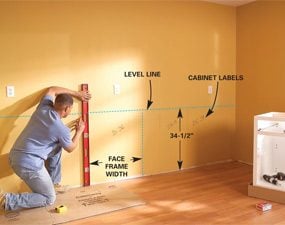
Kitchen Floor Cabinets Photo 1: Mark the cabinet height
Draw a level line on the wall 34-1/2 in. above the highest spot on the floor. Draw vertical lines to mark each cabinet location, label each cabinet's position on the wall and find and mark the studs.
Find the highest spot on the floor
Most kitchen floors are very flat, especially in homes less than 40 years old. But before installing cabinets, it's always best to confirm that by looking for the highest spot on the floor anywhere a cabinet will sit. You'll measure up from that spot and draw a level line to define the top of all of the base cabinets (Photo 1).
Find that spot with a straight 8-ft.- long 2×4 (or shorter to fit between the end walls if needed) and a 4-ft. level. Rest the 2×4 with the level on top about 1 ft. away and parallel to the wall and shim the 2×4 until it's level. Then mark the highest spot on the floor and repeat near any other walls that'll have cabinets. Continue until you find the highest spot. If you have two high spots, rest the board on both and find the highest one. Measure up the wall behind that spot exactly 34-1/2 in. (standard cabinet height) and mark the wall at that point. Using that mark as a starting point, draw a level line along the walls wherever base cabinets are planned (Photo 1).
Test-fit the base cabinets
In most cases, the corner cabinets determine where the rest of the cabinets go. That's especially true with lazy Susan corner cabinets, which have face frames facing two directions and have to meet adjoining cabinets perfectly. Our kitchen's "blind-corner" cabinets (Photo 2) are a bit more forgiving. Check your cabinet layout by "dry-fitting" all the base cabinets, starting with the corner ones, and setting all the cabinets in place as tightly together as possible. If the layout calls for filler strips, make sure to leave spaces for those, too. With the cabinets in place, check to make sure drawers and doors clear one another, appliance openings are the proper widths and sink bases center under windows above. Unless your cabinet plan is flawed, any adjustments you'll need to make are just a matter of ripping filler strips narrower or using wider ones. Next, remove the shelves, drawers and doors and mark them and their matching cabinets with numbered masking tape to save time and confusion later. Then move the cabinets out of the room.
Starting with the corner cabinets, carefully measure, draw and label each base cabinet and appliance location on the wall. Use a 4-ft. level and a pencil (Photo 1). The marks should reflect the width of the face frame, not the cabinet back. (The cabinet back is actually 1/2 in. narrower than the front, 1/4 in. on each side.) Use a stud finder or probe with nails to find and mark the stud locations just above the horizontal leveling line.
How to Install Kitchen Cabinets Step 3: Kitchen base cabinets: Level and set the boxes
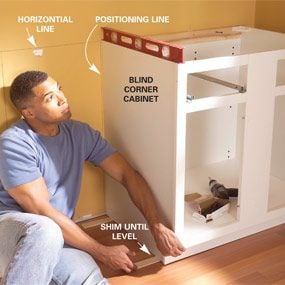
Kitchen Floor Cabinets Photo 2: Position the first cabinet
Set the first cabinet 1/4 in. from the positioning line and shim the base until the top is even with the horizontal line and level from front to back. Drive 2-1/2-in. screws through the back into the wall studs to anchor it.
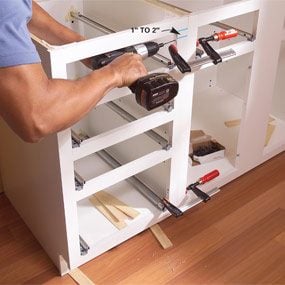
Kitchen Floor Cabinets Photo 3: Screw face frames together
Shim the next cabinet even with the horizontal line and level it. Clamp the frames together, drill 1/8-in. pilot holes, and screw the frames together with 2-1/2- in. screws. Then screw the cabinet to the wall studs.
Position the corner cabinets 1/4 in. away from the vertical positioning lines. Shim the base until the cabinet top is even with the horizontal leveling line and then level and shim the cabinet front to back (Photo 2). If there's a gap between the wall and the cabinet back (the wall isn't exactly plumb or straight), slip in shims and run screws into the studs through the cabinet back about 1 in. down from the top (see Photo 8). After all the base cabinets are set, score the shims with a utility knife and snap them off even with the cabinet top.
Position, level and shim the next cabinet and clamp it to the first cabinet (Photo 3). Run your fingers over the joint and you'll be able to feel if it's misaligned. Loosen each clamp one at a time and tweak the cabinet frames until they're perfectly flush, then retighten the clamp. Be fussy! Sometimes you'll have to loosen the screws holding the previous cabinet against the wall and pull it away slightly to get the frames aligned. When you're satisfied, drill pilot holes through the frames 1 to 2 in. from the top and bottom of the cabinet interior.
Make sure you're drilling straight. The most common mistake is to run the bit through the front of the cabinet frame! With the face-frame screws in place, remove the clamps and screw the cabinet to the wall. Repeat the same process for each consecutive cabinet.
How to Install Kitchen Cabinets Step 4: Base cabinets: Add filler strips
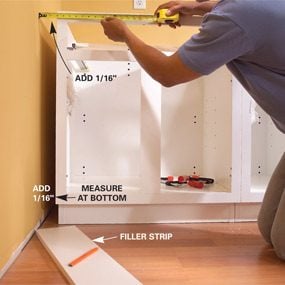
Kitchen Floor Cabinets Photo 4: Measure the gap
Measure the gap between the wall and the end cabinets at the top and bottom. Add 1/16 in. to each measurement and draw a cutting line on the backside of a filler strip.
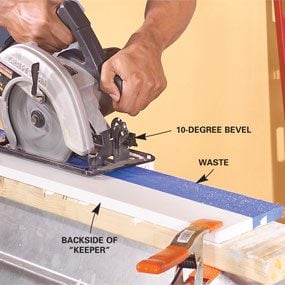
Kitchen Floor Cabinets Photo 5: Cut the filler strip
Clamp the filler strip and cut it at a 10-degree bevel from the backside so the wide edge of the "keeper" piece faces the front.
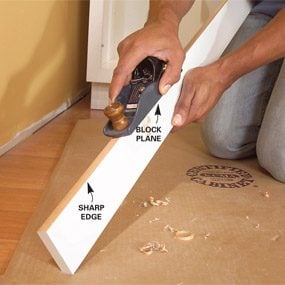
Kitchen Floor Cabinets Photo 6: Fit and install the filler
Test-fit the filler strip and plane the sharp edge of the bevel until it fits perfectly. Set the strip in place, predrill and screw it to the cabinet frame.
Add filler strips wherever the cabinets come up short of walls as we show in Photos 4 – 6 or wherever the plan calls for them. Leave the correct gaps for appliances. Some built-in appliances like dishwashers require very exact openings.
All manufacturers offer filler strips to match the wood type and finish of their cabinets. Generally they'll offer widths about 3, 6 and 8 in. cut in the same lengths as the height of the cabinet face frames. They fill spaces between end cabinets and walls, create additional spaces between cabinets or between cabinets and appliances for drawers and doors to clear, and close up odd gaps (Photo 4).
Spaces between cabinets and walls are rarely even, so you'll have to taper many filler strips. The best strategy when installing cabinets is to overcut slightly (1/16 in.), then plane or belt-sand the edge back. The 10-degree bevel simplifies this process (Photos 5 and 6). If you have a large piece left over, protect the surface with masking tape as we show and use it elsewhere. You won't be able to clamp filler strips when they're against walls, so fit them tightly to make drilling and screwing them to the cabinet easier. Fillers that are less than 6 in. wide can "float" against the wall and need no support. But fillers more than 6 in. wide should be supported. Nail them to a 1×2 backer board that's glued to the drywall directly behind the filler.
How to Install Kitchen Cabinets Step 5: Base cabinets: Make plumbing and electrical cutouts
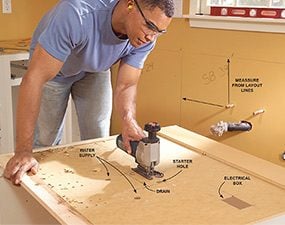
Kitchen Floor Cabinets Photo 7: Cut plumbing openings
Lay out plumbing and electrical openings on the cabinet back, using the layout lines on the wall as reference points. Then drill and/or saw out the openings.
You'll probably have to cut openings for the drain and water supply lines and for outlets (Photo 7). Lay out the openings by measuring from the layout lines at the top and side, and then transfer those numbers to the back of the cabinet. To avoid confusion, do the layout work with the cabinet near its position and in the right orientation. Drill holes for water supply lines and starter holes for square openings with a 1-in. spade bit. Stop drilling when the tip just penetrates the back, and finish the holes from the inside of the cabinet to prevent splintering the cabinet interior. Cut square openings with a jigsaw. If your drain line projects from the wall at an angle, simply cut a rectangular hole around it as we did.
How to Install Kitchen Cabinets Step 6: Set the peninsula cabinets
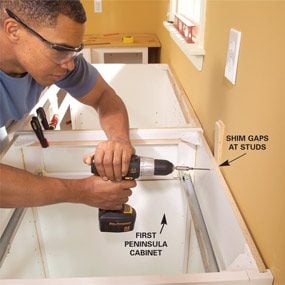
Kitchen Floor Cabinets Photo 8: Set the first peninsula cabinet
Orient the first peninsula cabinet at a right angle to the wall. Level and clamp it to the adjacent cabinet and screw it to the cabinet and the wall.
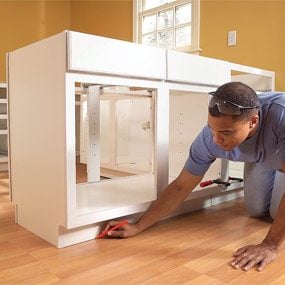
Kitchen Floor Cabinets Photo 9: Mark the position of the second cabinet
Position the next cabinet in line, clamp it and draw a line around the base. Make sure it's at a right angle to the other base cabinets. Set the cabinet aside.

Kitchen Floor Cabinets Photo 10: Install 2 x 2 support
Draw a second line to mark the thickness of the cabinet base, then screw 2x2s to the floor along the inner line.
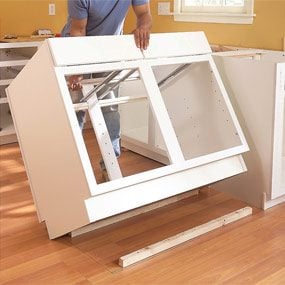
Kitchen Floor Cabinets Photo 11: Set the cabinet
Lower the cabinet over the blocking. Shim, clamp and screw the frames together. Screw the cabinet to the blocking with two screws from each side.
Level and screw the first peninsula cabinet to the adjoining standard base cabinet. You'll probably have to fill a 1/4-in. gap with shims before screwing it to the wall studs (Photo 8). If the first peninsula cabinet is only 2 ft. wide, you may have to clamp and screw filler strips to the frame so doors and drawers in the next cabinet will have operating clearance at the inside corner. This should be marked on your plan.
After the first peninsula cabinet is in place, anchor the cabinets that follow to permanent blocks on the floor. To do that, position the next peninsula cabinet and outline its base on the floor with a pencil (Photo 9). Then screw 2-by blocking to the floor after allowing for the cabinet base thickness (Photo 10). Don't try to place or cut the blocks perfectly. They can be short of the cabinet end by a couple of inches and back from the inside of the cabinet 1/8 in. or so. That way you won't have to struggle to fit the cabinet over the blocks. Screw the blocks into the subfloor with 2-1/2-in. screws spaced about every foot. Set the cabinet into place, level it with shims, then clamp and screw it to the neighboring cabinet and into the blocking.
Anchor island cabinets using the same positioning and blocking techniques we show for the peninsula cabinets. However, it's best to install your upper cabinets before starting on an island to keep a clear work area in the middle of the kitchen.
How to Install Kitchen Cabinets Step 7: Install the upper cabinets
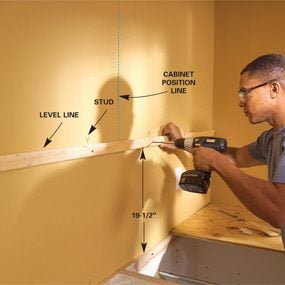
Kitchen Floor Cabinets Photo 12: Mark the cabinet positions
Draw a level line 19-1/2 in. above the lower cabinets and mark the upper cabinet positions. Screw a 1×2 ledger to the wall even with the level line.
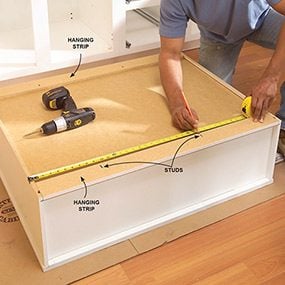
Kitchen Floor Cabinets Photo 13: Mark stud locations
Measure from the cabinet position lines to the stud locations. Mark the stud locations on the cabinet backs and drill 1/8-in. pilot holes through the hanging strips.
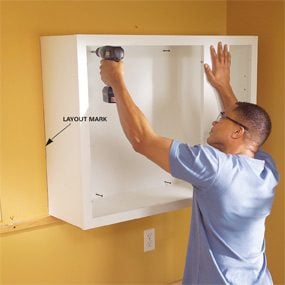
Kitchen Floor Cabinets Photo 14: Screw the cabinets to the wall
Start 2-1/2-in. screws, then rest the cabinet on the ledger. Align it with the cabinet position line and drive the screws into the wall studs.
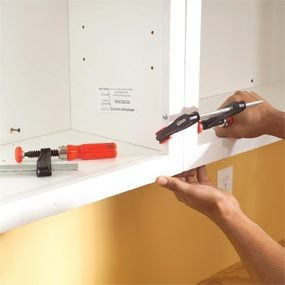
Kitchen Floor Cabinets Photo 15: Hang additional cabinets
Position the next cabinet and run the top screws partially into the studs to hold it in place. Align the frames, clamp them and screw the cabinets together. Then screw the cabinet to the wall.
The only tricky part about installing hanging upper cabinets is supporting them in exactly the right position while you screw them to the wall and one another. That's a tough, awkward task, especially if you're working alone. The ledger method simplifies this (Photo 12). It's a fail-safe method, but you'll have to accept a bit of patching and paint retouching to repair the screw holes left from the ledger.
Start by making a light pencil mark 19-1/2 in. up from the lower cabinets (it'll be 18 in. after the countertop is installed) and then mark the stud locations using the ones below as a guide. Next, transfer the cabinet positioning lines from below (Photo 12) and screw a 1×2 ledger to the studs even with the layout lines. It's best to prestart the cabinet screws before hoisting the cabinets up onto the ledger. Photo 13 shows an easy method to get the screws in the right place using the cabinet positioning lines and the stud locations on the wall and then transferring them to the cabinet. You'll often find that a cabinet, especially a narrow one, will have only one stud behind it. Don't worry; the other cabinets will help support it too.
Start any corner cabinets first. Space the first end cabinet exactly 1/4 in. away from the layout line and screw it to the wall. Be exact with the first cabinet because it will define the locations of all the rest of the cabinets on that wall.
Start the screws and hoist the next cabinet into place, snugging its frame against the neighboring one, and screw it to the wall. Next, align the frames and clamp them together as you did with the base cabinets (Photo 15). You'll probably have to back out the stud screws slightly in one or both cabinets to get the frames to line up perfectly. That's fine—leave the screws backed out while you clamp, drill and screw the frames together.
How to Install Kitchen Cabinets Step 8: Finish with doors and trim
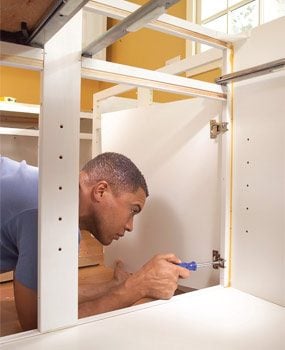
Kitchen Floor Cabinets Photo 16: Install cabinet doors
Replace the drawers, then rehang the doors and adjust the hinges to align the doors with one another.
Finish off the cabinets by cutting, fitting and nailing the toe-kick boards to the bases. They'll be 4 in. wide, but on irregular floors, you may need to rip them narrower to get them to fit. If you have bad gaps between the floor and the toe-kicks, add base shoe contoured to fit the floor. Wherever cabinets have finished ends, run the toe-kick boards 1/4 in. past the cabinet for a nice appearance. Finish up by slipping the drawers into their slides and reattaching the doors (Photo 16). Adjust the hinges until the doors line up perfectly, and move on to installing the door and drawer pulls.
Editor's Note: Complete Repairs and Painting Before Starting How to Install Kitchen Cabinets Project
After your old cabinets are torn out, and before learning how to install kitchen cabinets, is the perfect time to do any kitchen improvements. Here are some upgrades to consider:
- Electrical upgrades. Older kitchens are notorious for lacking adequate lighting and outlets. Consider adding undercabinet, task or indirect lighting and more outlets and upgrading all the outlets to GFCI-protected ones (now demanded by code). It's easy to cut open drywall, fish new wires and install electrical boxes because you can do the work behind the cabinets. Repairs won't have to be perfect because they won't show.
- Drywall repair. Patch any holes or any other drywall damage.
- Painting. Repaint all of the walls and the ceiling. You'll save the hassle of cutting in around the new cabinets and get a much neater job to boot. You can touch up nicks and bumps later.
- Install new finished flooring if you can. Most finished floor materials can be installed ahead of the cabinets. That's much easier to do because you can project the flooring under the cabinets and avoid cutting around them later. Hardwood flooring, tile, most vinyl and some laminate floors can handle cabinets resting on them with no problem. But be careful. Perimeter-glued vinyl and floating wood laminate floors need to expand and contract freely. If you rest cabinets on them, you may have problems with buckling, splitting or cracking later.
Required Tools for this How to Install Kitchen Cabinets Project
Have the necessary tools for this how to install kitchen cabinets DIY project and other kitchen cabinet projects lined up before you start—you'll save time and frustration.
Required Materials for this How to Install Kitchen Cabinets Project
Avoid last-minute shopping trips by having all your materials ready ahead of time for this how to install kitchen cabinets project. Here's a list.
Similar Projects
How to Install Kitchen Cabinets Step by Step
Source: https://www.familyhandyman.com/project/installing-kitchen-cabinets/